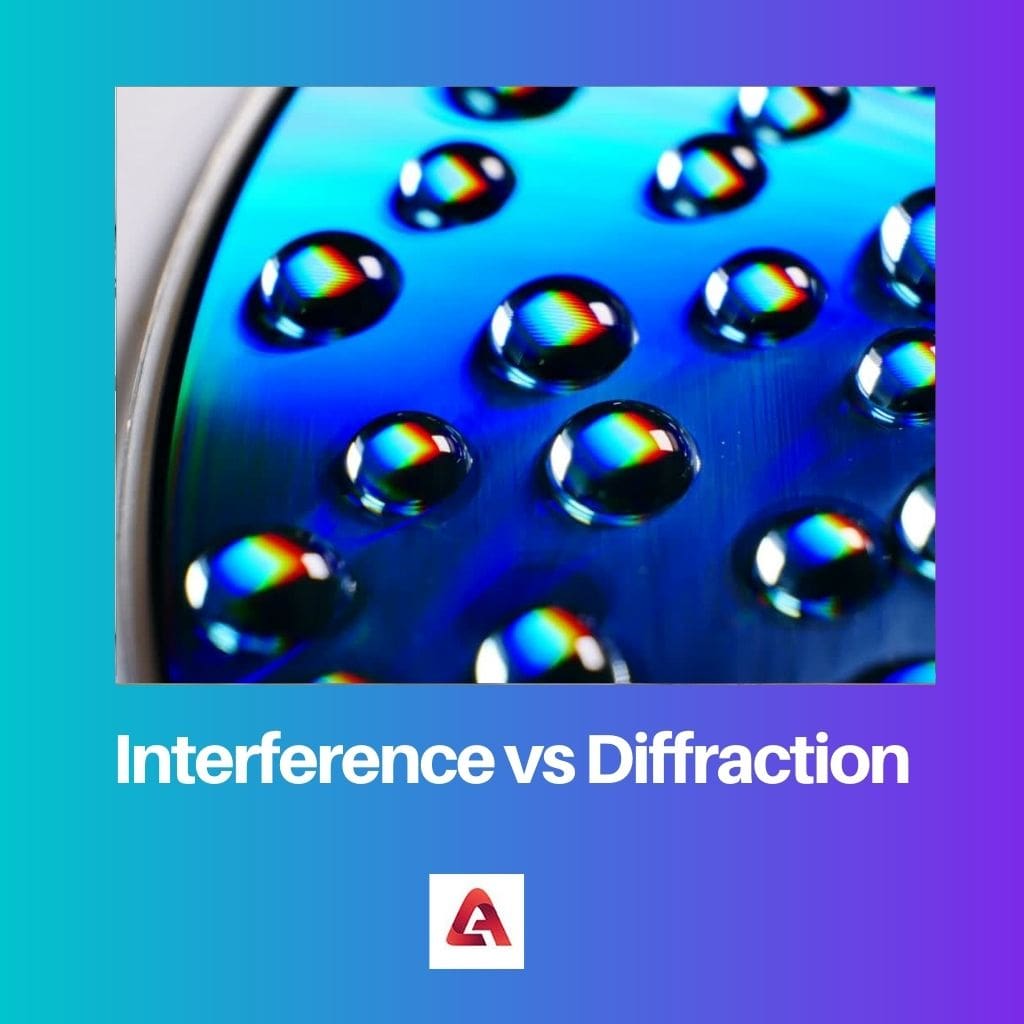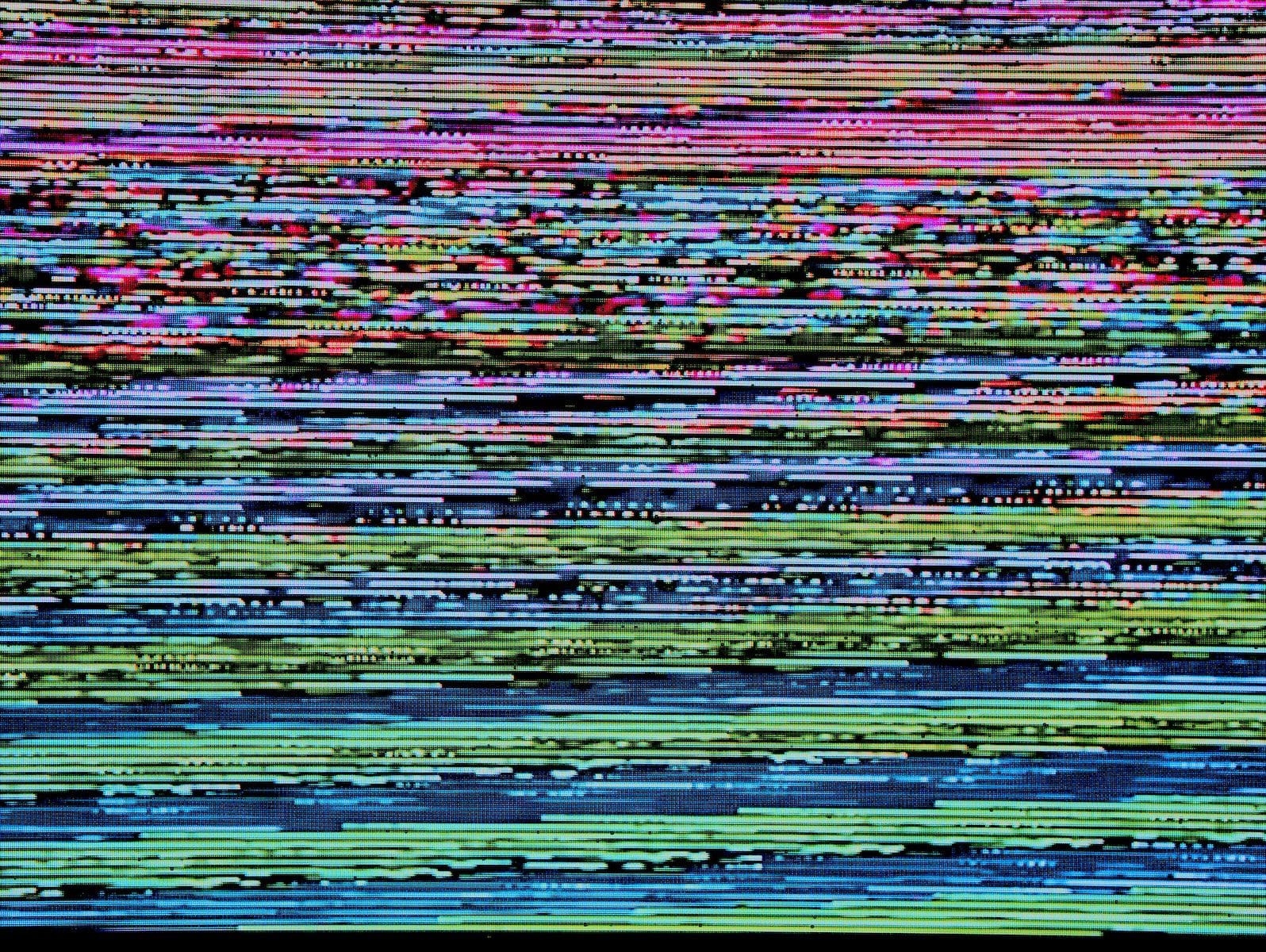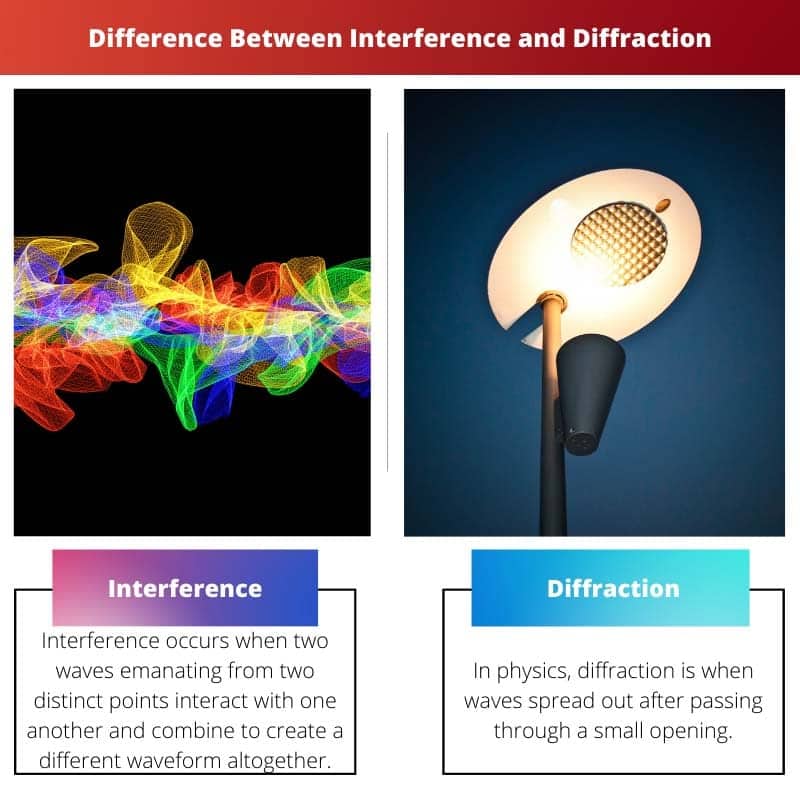Interference is the phenomenon where two or more waves superpose, leading to the reinforcement or cancellation of their amplitudes. Diffraction, conversely, involves the bending of waves around obstacles or through openings, resulting in the spreading of wavefronts and the formation of interference patterns.
Key Takeaways
- Interference is a wave phenomenon that occurs when two or more waves interact, either reinforcing or canceling each other out, depending on their phase alignment.
- Diffraction is the bending or spreading of waves as they encounter obstacles or pass through openings, producing a wave interference pattern beyond the obstacle or opening.
- The main difference between interference and diffraction is that interference occurs when multiple waves combine, while diffraction involves the bending or spreading of waves as they encounter barriers or openings.
Interference vs Diffraction
The difference Between Interference and Diffraction is the appearance of their waves. Interference occurs when the light waves combine through two different starting points. At the same time, diffraction appears due to the superposition of the subordinate wavelengths. The intensity of the edge of interference is always alike. And on the converse, diffraction has odd fringes.

Comparison Table
| Feature | Interference | Diffraction |
|---|---|---|
| Cause | Overlapping of waves from the same source | Bending of waves around an obstacle or passing through a slit |
| Result | Bright and dark regions where waves reinforce or cancel each other | Spreading of waves beyond the edge of an obstacle or widening of a slit image |
| Conditions | Requires coherent sources (waves in phase) and overlapping paths | Occurs with any type of wave, even incoherent sources |
| Examples | Double-slit experiment, thin-film interference | Ripples around a boat in water, shadow with fringes |
| Observation | Requires controlled environment or specific apparatus | More readily observed in everyday phenomena |
| Applications | Used in spectroscopy and optical coatings | Helps explain lens behavior and image formation |
What is Interference?
Interference refers to intervening or getting involved in the affairs or processes of a system, situation, or relationship, with the potential to disrupt, influence, or alter the natural course of events. This concept is prevalent in various contexts, including physics, communication, and social interactions, each with nuances and implications.
Interference in Physics
In physics, interference commonly refers to the interaction of waves, such as light or sound waves, when they overlap. This interaction can result in reinforcement (constructive interference) or cancellation (destructive interference) of the waves. For example, in optics, the interference of light waves can produce colorful patterns in thin films or diffraction gratings. Understanding interference is essential in fields like telecommunications, where engineers aim to optimize signal quality and minimize disruptions caused by interference.
Interference in Communication
In communication, interference can manifest as unwanted signals or noise that disrupt the transmission of information. This can occur in various forms, such as electromagnetic interference in radio communication or cross-talk in telephone lines. Efforts to minimize interference involve shielding, frequency management, and advanced modulation techniques to ensure the integrity of the transmitted signals. In a broader sense, interference in communication can also refer to external influences affecting the exchange of information, such as misinformation or intentional disruption.
Social and Human Interference
Beyond the scientific domains, interference plays a role in human interactions and relationships. Social interference encompasses external influences or interventions that impact the dynamics between individuals or groups. This can range from well-intentioned advice or guidance to unwanted meddling that disrupts natural processes. In legal contexts, interference can refer to actions that disrupt contractual relationships, leading to legal consequences. For instance, tortious interference occurs when a third party intentionally disrupts a contractual or business relationship between two parties, resulting in harm.

What is Diffraction?
Diffraction is a fundamental phenomenon in wave optics that occurs when waves encounter an obstacle or aperture and exhibit bending around the edges of the obstacle. It is a distinctive behavior observed in various types of waves, including light, sound, and water waves. Diffraction provides valuable insights into the nature of waves and plays a crucial role in understanding the behavior of waves in different contexts.
Huygens-Fresnel Principle
The Huygens-Fresnel principle is a foundational concept that helps explain diffraction. According to this principle, each point on a wavefront acts as a source of secondary spherical waves, and the sum of these secondary waves determines the shape of the overall wavefront. When a wave encounters an obstruction or a slit, these secondary waves interfere with each other, leading to diffraction patterns.
Characteristics of Diffraction
- Wave Bending: The most distinctive feature of diffraction is the bending of waves around obstacles or through openings. This bending is more pronounced when the size of the obstacle or slit is comparable to the wavelength of the wave.
- Intensity Patterns: Diffraction patterns result in wave intensity distribution in the space beyond the diffracting object. These patterns alternate bright and dark regions, commonly known as interference fringes.
Types of Diffraction
- Fraunhofer Diffraction: This occurs when the source, obstacle, and screen (where the diffraction pattern is observed) are effectively at infinite distances from each other. The resulting diffraction pattern is simpler and is commonly observed with light passing through a small slit.
- Fresnel Diffraction: In situations where the source, obstacle, and screen are at finite distances, such as with a point source of light illuminating a nearby obstacle, more complex diffraction patterns emerge.
Applications of Diffraction
- Optical Devices: Diffraction plays a crucial role in the design and functionality of various optical devices, including diffraction gratings, spectrometers, and holograms.
- Acoustic Diffraction: In acoustics, diffraction is essential for understanding how sound waves propagate around obstacles, impacting the design of concert halls, auditoriums, and other spaces.

Main Differences Between Interference and Diffraction
- Definition:
- Interference: Interference occurs when two or more waves meet at a point in space. The waves combine, leading to either reinforcement (constructive interference) or cancellation (destructive interference) of the amplitudes of the waves.
- Diffraction: Diffraction is bending waves around obstacles or spreading waves as they pass through openings. It involves the deviation of waves from a straight-line path.
- Cause:
- Interference: It is caused by the superposition of two or more coherent waves (waves with a constant phase relationship).
- Diffraction: It is caused by the bending of waves around obstacles or the spreading of waves when they encounter an opening or an edge.
- Nature:
- Interference: It involves the interaction of waves, leading to changes in amplitude at specific points in space.
- Diffraction: It involves the bending or spreading of waves as they encounter obstacles or openings, leading to changes in the direction of propagation.
- Resultant Pattern:
- Interference: It results in an interference pattern with alternating regions of constructive and destructive interference.
- Diffraction: It results in a diffraction pattern, including a central bright region and alternating dark and light fringes.
- Conditions:
- Interference: Requires coherent sources (sources with a constant phase relationship) and involves waves of the same frequency.
- Diffraction: Can occur with a single wave source and is not strictly dependent on the coherence of sources.
- Applications:
- Interference: Used in various applications, including interference microscopy, interferometry, and thin-film interference in optics.
- Diffraction: Commonly observed in everyday phenomena, such as the bending of sound waves around obstacles and in various optical devices like diffraction gratings.
- Examples:
- Interference: Young’s double-slit experiment is a classic example of interference.
- Diffraction: The single-slit diffraction pattern and the diffraction grating are common examples of diffraction.

- https://journals.aps.org/prl/abstract/10.1103/PhysRevLett.74.3600
- https://cds.cern.ch/record/396122/files/0521642221_TOC.pdf
- https://ui.adsabs.harvard.edu/abs/1999OptEn..38.1051D/abstract

The article’s exploration of interference and diffraction is a testament to the author’s expertise in wave optics, rendering complex concepts accessible to a wider audience.
Absolutely, the article’s insightful commentary on interference and diffraction is both intellectually stimulating and accessible.
The comprehensive analysis of interference and diffraction in the article offers a profound understanding of these wave phenomena.
The explanation of interference and diffraction is clear and accessible, making it easier for readers to grasp these complex wave phenomena.
Absolutely, the relatable examples and real-world applications enhance the overall understanding of interference and diffraction.
The article effectively captures the essence of interference and diffraction, providing a compelling overview of these wave phenomena.
Indeed, the engaging narrative and illustrative examples enhance the understanding of interference and diffraction.
The article provides valuable insights into interference and diffraction, serving as an excellent educational resource for students and enthusiasts alike.
I couldn’t agree more! The detailed overview of interference and diffraction is highly informative and engaging.
The practical examples and real-world applications of interference and diffraction in the article are truly illuminating.
The article presents a comprehensive overview of interference and diffraction, shedding light on their distinct characteristics and applications.
I couldn’t agree more! The practical examples provided help solidify the understanding of these wave phenomena.
Indeed, the section on the Huygens-Fresnel principle and characteristics of diffraction is particularly enlightening.
…
The article provides a highly informative and well-structured analysis of interference and diffraction, offering valuable insights for readers.
Absolutely, the comprehensive coverage of key concepts and practical applications in the article is truly commendable.
The intricate concepts of interference and diffraction are elucidated with remarkable clarity and precision in the article.
Absolutely! The article’s detailed explanations and illustrative examples make these complex topics more accessible.
The distinction between interference and diffraction is elucidated with precision and clarity, allowing for a more profound comprehension of these concepts.
Indeed, the in-depth analysis of interference and diffraction provides a solid foundation for understanding wave phenomena in optics and beyond.
Absolutely, the article’s exploration of interference and diffraction is well-crafted and thought-provoking.
This is a fantastic explanation of interference and diffraction! I appreciate the thoroughness and detail provided.
Absolutely! The comparison table is particularly helpful in highlighting the key differences between interference and diffraction.
I agree! The clarity in the explanation really makes these concepts easier to understand.